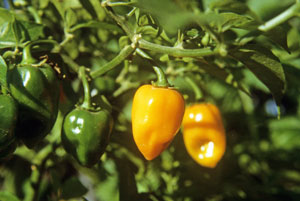The habanero relatives that we have collected and planted over the years are but a small fraction of the total number of pod types in the species. However, they paint a fascinating picture of the world of this intriguing species of chile pepper.

Orange habanero from the Yucatán
In the United States, most commercial habanero seeds are generic (meaning that their precise origin is not specified), although some varieties such as ‘Red Savina’ are appearing in seed catalogs. For growers who wish to find exotic chinense seeds, we suggest Seed Saver’s Exchange or the U.S. Department of Agriculture’s Plant Introduction Station in Georgia (see Sources at the end of this article).
The seeds tend to take a long time to germinate, and bottom heating is the key to speeding up the process. The chinense, being tropical plants, do best in areas with high humidity and warm nights, but we have heard reports of chinense varieties growing well in such diverse locations as northern California, Texas, Illinois, and Louisiana. Wherever they are planted, however, they are slow growers, especially in the Southwest, and the growing period is at least 100 days or more after transplanting for mature pods.
The yield varies enormously according to the varieties grown and how well the particular plants adapt to the local environment; we have grown stunted plants with as few as ten pods and large, bushy plants with fifty or more.
The key to good growth seems to be a loose, friable soil that is well-drained but kept moist. After years of growing, we know to add organic matter to the garden soil in the form of aged manure and sawdust, compost, peat moss, or a combination of all three. For container soil, vermiculite and perlite are added to commercial potting soil along with a little sand to promote drainage. Don’t use garden soil for containers unless it is thoroughly mixed half and half with the above mixture.
During the growing season, take care not to over-fertilize, or you will have spectacular leaf growth and few pods. Any type of stress on the plant, such as withholding water, will tend to make the pods hotter. In hot and dry dessert climates, providing a sunscreen or partial shade can prevent sunscald and encourage vegetative growth.
Harvesting
As the plant flowers and sets fruit, there will be pods in all stages of maturity. Of course, the ripe, brightly colored pods are the most desirable, but the green pods are also good to cook with, if not quite as hot and flavorful. In some cases, with highly prolific plants that are setting dozens and dozens of pods, be sure to pick the pods as they get ripe. You may pick green ones as the plant approaches its “fruit load”–the maximum number of pods that a plant can hold.
If you are collecting seed, remember that only mature pods in full color will have seeds that will germinate. After picking, the length of time the pods will remain usable varies according to temperature, humidity, and storage. Fresh pods will last a week or so in the house, and a couple of weeks in the refrigerator. Clean all excess moisture off the habaneros before storing them in a plastic bag in the refrigerator. Inspect them every few days for mold and use them as soon as possible.
Storing
Over the years, many people have asked us how to preserve the habanero crop. The simplest method is to wash and dry the pods and place them in a plastic bag in the freezer. They will lose some of their firmness when defrosted, but the flavor, heat, and aroma are all preserved. Habaneros can also be pureed with a little vinegar and the mixture will keep in the refrigerator for weeks.
Another common preservation method is drying the pods. They should be cut in half vertically, seeds removed, and placed in a food dehydrator. After they are thoroughly dried, they can be stored in jars, stored in plastic bags in the freezer, or ground into powders (be sure to wear a dust mask!). Drying does not affect the heat level of the pods, but pods that are rehydrated will lose some flavor and aroma.
Remember, sauces and salsas are a great way to utilize excess habaneros from the garden!
Latest posts by Dave DeWitt (see all)
- Enchiladas Verdes con Chile Pasado - 02/08/2023
- Smoked Oysters with Ancho Chile Sauce - 01/13/2023
- Machaca Sierra Madre - 01/11/2023







